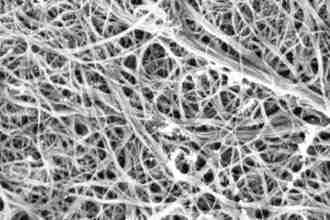Dec 16 2012
For years, there has been a growing demand for materials that are lightweight with high mechanical strength. Metal matrix composites (MMCs) were developed in order to fulfill this demand and provide stiffness and strength to a light or low-density structure that alloys and metals cannot match. Stiffness and strength of materials used in load bearing applications is key as they reduce the mass and dimensions of the materials. Research has been conducted on the usage of carbon nanotubes (CNTs) as reinforcements for composite materials.
What are Nanocomposites?
Nanocomposites are multiphase solid materials with nano-scale repeat distances between their phases. A wide variety of synthetic nanocomposites have been created, but these materials can also be found in nature, as in the structure of the bone and the abalone shell.
In comparison with conventional composite materials, nanocomposites typically have a higher surface area to volume ratio of the reinforcing phase and also a high aspect ratio. Many metals can be reinforced using nanostructured materials as fillers or as part of an alloy - titanium, aluminium and steel are common materials to use in nanocomposites, as they are the most commonly used engineering metals, and so offer the greatest potential commercial benefit from enhanced mechanical properties and lighter weight.
- Polymer-Matrix Nanocomposites: Also known as nanofilled polymer composites, these consist of a nanomaterial filler added to a polymer matrix. Proper dispersion of the filler yields composites with high performance.
- Metal-Matrix Nanocomposites: Metal matrix nanocomposites, also known as reinforced metal matrix composites, are divided into non-continuous and continuous reinforced materials. Nanoparticles of other metals, non-metals, or more exotic nanomaterials like carbon nanotubes can used to develop composite materials that have good electrical conductivity and high tensile strength.
- Ceramic-Matrix Nanocomposites: Ceramic nanocomposites usually consist of metal nanoparticles dispersed through ceramic matrix, in order to enhance the physical and mechanical properties of the material.

As well as being a fascinating material in their own right, carbon nanotubes have shown interesting properties when used to enhance metal composite materials. Image credit: NASA
Properties of Carbon Nanotube Metal Matrix Composites
The properties of CNT metal matrix composites are listed below:
- CNTs are dispersed homogenously through the metal, with strong interfacial adhesion between the CNTs and the metallic matrix.
- CNT metal matrix composites have excellent electrical properties and are used as reinforcement to metals in order to enhance their electrical properties.
- Carbon nanotubes have extremely high thermal conductivity that allows metal matrix carbon nanotubes to be used for thermal management.
- The thermal properties of CNT metal matrix composites can be improved based on the distribution and bonding of CNTs with the matrix.
- CNT metal matrix composites production is economically viable
- Composite coatings have an increase in their corrosion resistance when CNT is added to them
- Metal matrix composites have high thermal conductivity and low coefficient of thermal expansion.
Applications of CNT Metal Matrix Composites
The applications of CNT metal matrix composites in different industries are listed below:
- Electronic packaging industry: Solders and heat sinks for thermal management
- Automobile industry: gears, break shoes, piston rings and cylinder liners
- Sports industry: badminton and tennis rackets and light weight bicycles
- Space applications: structural radiators and high gain antenna boom
- Aerospace industry: landing gears and aircraft brakes
- MEMS and sensors battery and energy storage: hydrogen storage materials, micro-beams and micro-gears, anodes and anode coatings
Some of the other applications of CNT metal matrix composites include:
- They are used as catalysts and sensors
- They are available as a paste of metallic nano-particles with CNTs in liquid medium that allows them to be dried as a film and then used as electrodes in sensor devices or they can be directly used as electrodes in bulk form.
Recent Developments
There has been a lot of activity recently in the study of carbon nanotube metal matrix composites. Reports suggest that such activities have become a lot more feasible recently because of the availability of good quality CNTs at affordable prices. This has widened the application range of carbon nanotubes with metal matrix composites that are used in different engineering sectors.
A number of new methods have recently been developed to improve the dispersion of the CNTs and new thermal spray techniques have been developed to synthesize metal matrix carbon nanotube coatings at a much larger scale.
Conclusion
Based on new discoveries and improvements related to carbon nanotube metal matrix composites there seems to be tremendous scope for further developments on these composites in the future. Dispersion of very fine CNTs in the microstructure in a uniform manner is currently a popular topic of research. Developments in the future will focus on the applications of carbon nanotube metal matrix composites, and also on any potential health hazards caused by the production or use of these nanocomposites.
Sources and Further Reading
- "Carbon nanotube reinforced metal matrix composites - a review" - S.R. Bakshi, D. Lahiri and A. Agarwal, Int. Mater. Rev., 2010. DOI: 10.1179/095066009X12572530170543
- "Fabrication of an aluminum–carbon nanotube metal matrix composite by accumulative roll-bonding" - S. Salimi, H. Izadi and A. P. Gerlich , J. Mater. Sci., 2011. DOI: 10.1007/s10853-010-4855-z
- "Particulate Titanium Matrix Composites Tested-Show Promise for Space Propulsion Applications" - NASA Glenn Research Center